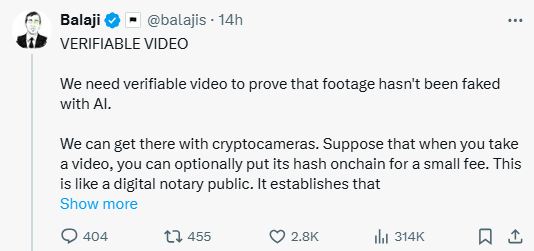In a world where AI can easily manipulate video content, the need for technology that can prove the authenticity of footage has never been more urgent.
A prominent investor and tech personality, Balaji suggests Cryptocameras – a revolutionary idea that could make deepfakes and other AI-generated video manipulations far more difficult to pull off.
The concept is simple yet powerful: imagine a camera or smartphone that, when you record a video, gives you the option to attach a verifiable timestamp and a digital fingerprint (hash) to the footage–all recorded securely on the blockchain.
This process acts like a digital notary, providing two key assurances:
- The video existed at a specific time.
- You, the user, are the ones who uploaded it to the blockchain.

While this doesn’t mean the video can’t still be manipulated later with AI, the blockchain ensures that the original footage can be traced back to its creation and cannot be easily tampered with. Think of it as a secure, unchangeable proof of authenticity.
The idea isn’t just theoretical. According to Balaji, a prominent tech visionary, this type of verifiable video could be integrated into existing platforms like social networks. It would be as simple as switching to a “verifiability” mode on your camera app—just like slow-motion or time-lapse. You’d pay a small fee to get the video’s hash written to the blockchain in real-time, ensuring it’s tamper-proof and verified.
This means that shortly, citizen journalists or everyday users sharing video footage could include a “verified” checkmark next to their videos, signaling that their content is trustworthy and hard to manipulate. As AI tools continue to improve, the pressure for social networks to adopt such features could rise, with unverified content becoming increasingly suspect.
The potential of cryptocameras doesn’t stop with social media. This concept could be expanded to fields like science and research, where it could provide verifiable proof of data integrity.
Imagine if critical data like DNA sequencing results, temperature measurements, or scientific observations were recorded with the same level of blockchain-secured verification. This could help fight issues like academic fraud and the replication crisis, ensuring that the data is reliable and unaltered.
As AI becomes more capable of creating convincing fakes, the need for tools that can prove what’s real is growing stronger. Cryptocameras represent a potential solution to this problem, combining the power of blockchain with everyday technology.
Also Read: Open AI whistleblower death causes ripples, Elon Musk responds







